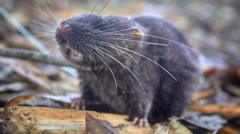In a thrilling expedition, scientists from Conservation International and local indigenous groups have uncovered 27 new species in the Alto Mayo region of northern Peru, which encompasses parts of the Amazon rainforest. Among the fascinating finds are an amphibious mouse with webbed feet, a newly identified “blob-headed” catfish, and a tiny dwarf squirrel measuring just 14cm in length.
Trond Larsen from Conservation International marveled at the discovery: "It's incredible to find so many new vertebrate species in such a human-influenced area." Despite the region's pressures from deforestation and agriculture, this biodiversity shines a light on its ecological significance. The expedition's results also include eight fish species, three types of amphibians, and 10 butterfly species, with potential for even more undiscovered species.
Notably, this exploration is significant for the indigenous Awajún people, who possess deep traditional knowledge of the local ecosystems. Their collaboration in the research is not just crucial for scientific aiming but also aids in the protection and understanding of their rich inheritance. The discoveries confirm their longstanding connection with the land, as they were already aware of the newly found “blob-headed” fish.
The uniqueness of the environment was showcased with an exceptional new species of climbing salamander and the extraordinary spiny mouse, which boasts stiff guard hairs akin to a hedgehog's spines. Overall, this expedition represents an important step toward recognizing and preserving the invaluable biodiversity of Peru’s Amazon region.
Trond Larsen from Conservation International marveled at the discovery: "It's incredible to find so many new vertebrate species in such a human-influenced area." Despite the region's pressures from deforestation and agriculture, this biodiversity shines a light on its ecological significance. The expedition's results also include eight fish species, three types of amphibians, and 10 butterfly species, with potential for even more undiscovered species.
Notably, this exploration is significant for the indigenous Awajún people, who possess deep traditional knowledge of the local ecosystems. Their collaboration in the research is not just crucial for scientific aiming but also aids in the protection and understanding of their rich inheritance. The discoveries confirm their longstanding connection with the land, as they were already aware of the newly found “blob-headed” fish.
The uniqueness of the environment was showcased with an exceptional new species of climbing salamander and the extraordinary spiny mouse, which boasts stiff guard hairs akin to a hedgehog's spines. Overall, this expedition represents an important step toward recognizing and preserving the invaluable biodiversity of Peru’s Amazon region.



















